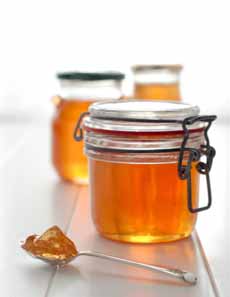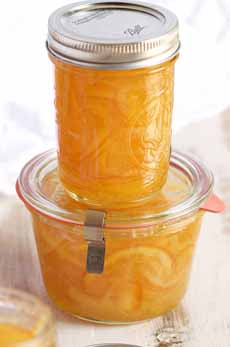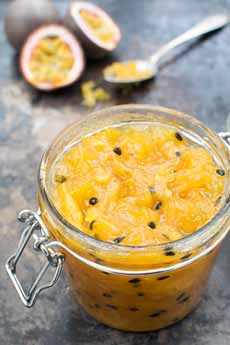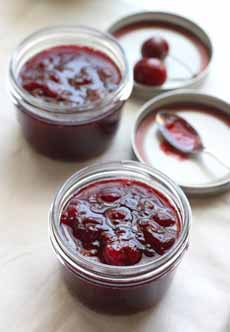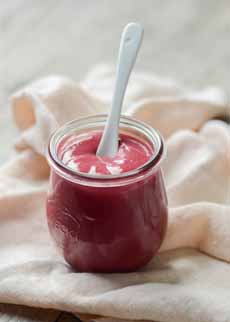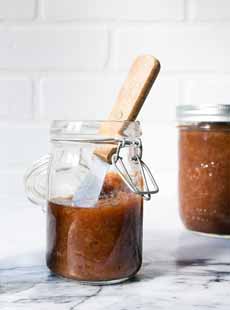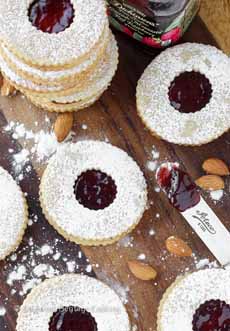FOOD 101: The History Of Jam, Jelly & Preserves
|
We’ve already done a turn on the the history of peanut butter. Today it’s the history of jam and jelly.
Before we start on its history, check out the different types of fruit spreads: not just jam, jelly, and preserves, but chutney, conserve, curd, fruit butter, and marmalade. The history of jam and preserves begins with the history of food preservation. After all, it was only a few centuries ago that technology was created to store foods over long periods. By the Paleolithic period 2.6 million years ago*—also called the Stone Age, and marked by the earliest known use of stone tools—people were preserving food. They had already realized that if they could save food they collected in times of plenty, it would make survival easier during times of scarcity. They could also avoid having to constantly roam greater and greater distances to look for fresh food. The earliest natural methods of preserving food were: The first steps toward modern preservation methods were spurred by Napoleon Bonaparte in 1785. He needed to send food with his armies that wouldn’t spoil but preserve the food they needed. Thus canning came to be, enabling fruits and vegetables in all their forms to be preserved until the next year’s bounty, followed somewhat later by mason jars for home cooks. Here’s the history of canning and the history of mason jars. Credit cooks in the Middle East as the first to make jam and preserves, though historians can’t pinpoint the date. It was before the 11th century; we just don’t know how much before. It may have been the 4th century or earlier. Recipes for fruit preserves (using honey) can be found in the oldest cookbook to survive from antiquity: De Re Coquinaria (“The Art of Cooking”). The book is believed to be published in the late fourth or early fifth century, and is attributed to “Marcus Gavius Apicius.”* ________________ *The Paleolithic is considered to have ended around 10,000 B.C.E. †This is considered a pseudonym of the author(s), honoring a famous epicure by that name who lived some four centuries earlier. While honey could be used to sweeten jams and preserves, it was sugar that became the sweetener of preference. The people of New Guinea in the South Pacific domesticated sugar cane some 10,000 years ago. It was later planted in India, where growers in the Ganges Delta became adept at refining the sweet cane juice into crystallized sugar. Darius The Great (549-485 B.C.E.) brought sugar cane back to Persia following his invasion of India. Persia became a prolific sugar-producing region, and Middle Easterners had lots of it. Not so, the countries to the north. Jump to the 11th century and the Crusades. Amazingly, sugar was only discovered by Western Europeans in the 11th Century C.E., as a result of the Crusades (1095 to 1291). Crusaders returning home talked of how pleasant the “new spice” was. The first recorded mention of sugar in England was in 1099 [source]. But it wasn’t cheap. As an example, a record from 1319 C.E. cites sugar available in London at “two shillings a pound.” That’s about $50 per pound in today’s money. So jellies, preserves, and other sugar-based foods would have been restricted to royalty and the wealthy. Marmalade is believed to have been created in 1561 by the physician to Mary, Queen of Scots. He crushed oranges and sugar as a remedy for her seasickness. For more pleasant uses, royal sweet tooths kept royal kitchen staff busy. The magnificent feasts of Louis XIV always ended with marmalades and jellies served in silver dishes, eaten with silver spoons (so don’t feel guilty about dipping into the jar with your stainless steel flatware). Not that Louis and his acquaintances watched their pennies, but sugar wasn’t cheap. It didn’t trickle down to the bourgeoisie (or the British middle classes As an example, we have a record from 1319 C.E. citing sugar available in London at “two shillings a pound.” That’s about $50 per pound in today’s money. Unless money knew no boundaries, sugar was a luxury. Finally, with the enormous expansion of industry and opportunity starting with the Industrial Revolution of the 19th century, most people could afford sugar for their coffee and tea. Jelly came centuries later. It required gelatin to set it. (In modern times, pectin derived from fruits is used.) Gelatin (also spelled gelatine) had been made since ancient times by boiling animal and fish bones and connective tissues. It was a laborious process, undertaken largely by the kitchens of the wealthy, which had the staff resources to undertake it.‡ Aspic, made from meat or fish stock, appears in Egyptian wall paintings. It seems to have dropped from sight, sometime after the fall of Ancient Egypt (30 B.C.E.) and the sack of Rome by the Visigoths in 410 C.E., which led to more sacking by other peoples and the Dark Ages. No one had enough to eat of the basics, much less laboriously crafted fare. |
|
|
|
Aspic later resurfaced as a French darling at the beginning of the Renaissance, around 1400. Kitchens of the wealthy turned out fancy aspics and desserts. Powdered gelatin was invented in 1682 by Denis Papin, a French physicist, mathematician, and inventor. It made the production of jelly so much easier and enabled the development of other foods that required stiffening. And that’s why jelly came much later. Interestingly, Papin’s Wikipedia page doesn’t mention gelatin—just his scientific inventions. No doubt, inventing the forerunner of the steam engine tops jelling food. Here’s a longer history of gelatin. By the way: The word jelly comes from the French word gelée, meaning to congeal or gel. The word jam appears in 18th-century English from the word meaning to press tightly. The word marmalade appeared in the late 15th century, derived from the Portuguese word for quince jam, marmelada. ________________ ‡The primary use for gelatin was as glue. |
||
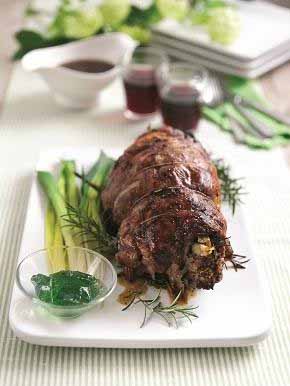 [7] Lamb roast with mint jelly, a British classic (photo © Welsh Beef & Lamb).
|
Sugar Comes To The West Indies
Arab trade brought sugar to southern Europe through Spain, and the first Spanish explorers carried it to the New World. It is recorded that in 1493, Christopher Columbus brought sugar cane plants to grow in the West Indies. The crop thrived, and the region became Europe’s main source of sugar, beginning around 1500. Sugar was the main crop produced on plantations throughout the Caribbean beginning in the 18th century, leading to a boom in the Caribbean economies through the 18th, 19th, and 20th centuries. These plantations produced 80% to 90% of the sugar consumed in Western Europe. A by-product of refining sugar was molasses, given to the slaves for sweetening their food. One clever fellow discovered that fermenting the molasses made a delicious drink: rum. As global trading grew, the price of sugar became affordable in the 19th century to middle and lower-income families in Europe and the U.S. But sugar was a precious necessity. In 1888, the American folk song Drill, Ye Tarriers, Drill, has railroad workers lamenting, “Oh it’s work all day for the sugar in your tay” [tea]. And that meant sugar for your jams and jellies, candies, and desserts, too. From European royalty to Americans to American pioneers, to energizing troops during battle, to making life sweeter for children and invalids, and just about everyone else: Jams and preserves came to the U.S. with colonists. As a teenager in 1792, John Chapman, better known as Johnny Appleseed, a nurseryman (the title in those days), moved from western Pennsylvania to Ohio. In 1805 began his apprenticeship as an orchardist with an apple grower. He noted the U.S. surge westward in the early 1800s and decided on his life’s journey: planting apple trees throughout the Midwest, so incoming pioneers could make cider and jam. One of those pioneers was Jerome Monroe Smucker of Orrville, Ohio, a farmer who opened a cider mill in 1897 using fruit that Johnny Appleseed had planted. Within a few years, he was also making apple butter, in a copper kettle over a wood stove. Jerome and his wife Ella ladled the apple butter into stoneware crocks, and Ella then sold it from her horse-drawn wagon to other housewives in the county. Today their venture is worth more than $15 billion. |
|
|
CHECK OUT WHAT’S HAPPENING ON OUR HOME PAGE, THENIBBLE.COM.
|
||
